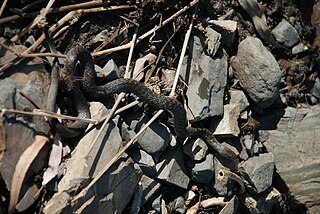
The Nilgiri keelback, also known commonly as Beddome's keelback, is a species of snake found in the Western Ghats in India. The species is named after Richard Henry Beddome, 1830–1911, British army officer and naturalist. It was first discovered near the Nilgiris but is now known more widely from the Western Ghats. This snake is terrestrial and feeds on toads.

Hebius khasiensis, commonly known as the Khasi Hills keelback or Khasi keelback, is a species of colubrid snake endemic to southeastern Asia.
Hebius modestus, commonly known as the modest keelback or Günther's keelback, is a species of natricine snake endemic to Asia.
The Yunnan keelback is a species of natricine snake which is endemic to Asia.
The Assam keelback, commonly known as Peal's keelback, is a species of snake in the subfamily Natricinae of the family Colubridae. The species is endemic to Northeast India. It has recently been rediscovered after 129 years in Arunachal Pradesh.

The Himalayan keelback is a species of grass snake in the family Colubridae. The species is endemic to South Asia.

The buff striped keelback is a species of nonvenomous colubrid snake found across Asia. It is a typically nonaggressive snake that feeds on frogs and toads. It belongs to the subfamily Natricinae, and is closely related to water snakes and grass snakes. It resembles an Asian version of the American garter snake. It is quite a common snake but is rarely seen.

Rhabdophis plumbicolor, known as the green keelback or lead keelback, is a species of nonvenomous snake in the family Colubridae native to parts of the Indian subcontinent.

The checkered keelback, also known commonly as the Asiatic water snake, is a common species in the subfamily Natricinae of the family Colubridae. The species is endemic to Asia. It is non-venomous.

Storeria dekayi, commonly known as De Kay's brown snake, De Kay's snake, and simply the brown snake, is a small non-venomous species of snake in the family Colubridae. The species is native to North America and Central America.
Common keelback may refer to several species of colubrid snakes of the subfamily Natricinae:

The Japanese keelback is a species of colubrid snake, which is endemic to Asia.
Thermophis baileyi, also known commonly as Bailey's snake, the hot-spring keelback, the hot-spring snake, and the Xizang hot-spring keelback, is a rare species of colubrid snake endemic to Tibet.

The crayfish snake, also known commonly as the glossy crayfish snake, the glossy swampsnake, the glossy water snake, and the striped water snake, is a species of semiaquatic snake in the subfamily Natricinae of the family Colubridae. The species is endemic to the southeastern United States, and preys mainly on crayfish.
Rhabdophis ceylonensis is endemic to the island of Sri Lanka. The species is commonly known as the Sri Lanka blossom krait, the Sri Lanka keelback, and මල් කරවලා or නිහලුවා (nihaluwa) in Sinhala. It is a moderately venomous snake.
Hemiaspis damelii is a species of venomous snake in the family Elapidae. It is a relatively small species of elapid with a mean snout-vent length (SVL) of 42.6 to 60 cm. The species is endemic to eastern Australia and is most commonly found across central inland New South Wales through to the interior of south-eastern Queensland. Common names for this species include grey snake and Dämel's Snake. The specific name, damelii, is in honor of German entomologist Edward Dämel, who collected Australian specimens for Museum Godeffroy.
Tropidonophis doriae, commonly known as the barred keelback, is a species of snake belonging to the family Colubridae. The species is native to New Guinea and some nearby islands.

Tropidonophis is a genus of snakes in the subfamily Natricinae of the family Colubridae.
Hebius venningi, commonly known as the Chin Hills keelback or Venning's keelback, is a species of snake in the family Colubridae. The species is endemic to Asia.
Tropidonophis dahlii, also known commonly as the New Britain keelback, is a species of snake in the family Colubridae. The species is native to Indonesia and Papua New Guinea.











